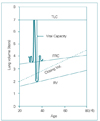Exercise in the Elderly
Article information
Abstract
The health benefits from exercise, particularly in a sedentary society, have gained a compelling body of evidence in the past decade. Younger adults have a considerably bigger physiologic reserve, both in terms of muscular strength and cardiovascular capacity. The elderly, on the other hand, experience a progressive decline in many physiologic functions, including muscular strength and cardiovascular capacity. Habitual exercise, by improving strength and maximum aerobic capacity (VO2max), can increase the physiologic reserve as well as enhance well-being by reducing fatigue associated with activities of daily living. Mostly importantly, it can delay the development of disability and thereby prolong active life expectancy. In addition to habitual exercise for conditioning, there is increasing evidence that resistance exercise to improve muscle strength along with tailored exercise therapies, including those designed to improve balance or to rehabilitate persons with various chronic diseases and acute ailments, may be of special value for the elderly. There is growing evidence that exercise programs offer measurable health benefits, ranging from increased life expectancy to mitigation of adverse sequelae from aging and from many chronic diseases. The greatest challenges in achieving health benefits from exercise are the limited access to effective programs and poor compliance.


